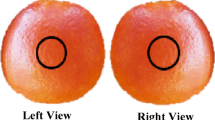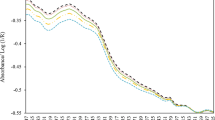Abstract
Red pepper (Capsicum annuum L. cv. Capia) is an important vegetable obtained from a 1-year cultivated plant belonging to the Solanaceae family. Among the products of red pepper, its paste is very similar to tomato paste in appearance; however, it differs in terms of flavor properties. The wide-ranging quality parameters (dry matter, soluble solids, pH, titration acidity, salt, insoluble ash, total reducing sugars, color values, total carotenoid, antioxidant properties, browning index, and 5-hydroxymethylfurfural) of commercial sweet pepper pastes (n = 52) were determined. To the best of our knowledge, this study is the most comprehensive study on determining the quality parameters of red pepper paste, and its in-depth results will help food authorities issue registrations related to commercial pepper paste in countries such as Türkiye. Additionally, near-infrared (NIR) spectroscopy-based machine-learning algorithms were evaluated for the first time in paste samples as a rapid alternative or complementary to the conventional analytical methods. Regarding the conditional entropy-based models, successful predictions with high accuracy were developed for all the quality parameters of pepper paste. Except for the coefficient of determination value of 0.69 and 0.85 in the prediction of HMF and a/b color values in the developed models, respectively, 0.96 or higher coefficients of determination were obtained for all other parameters. Therefore, NIR spectroscopy, along with the conditional entropy-based predictions, enables simple, fast, multiparametric and accurate quantitative prediction of the numerous quality parameters for commercial sweet pepper pastes and has the potential to be used in routine quality control analyses by pepper paste producers.



Similar content being viewed by others
Data availability
The data that support the findings of this study are available from the corresponding author, [Ç. U. PALA], upon reasonable request.
References
Arimboor R, Natarajan RB, Menon KR, Chandrasekhar LP, Moorkoth V (2015) Red pepper (Capsicum annuum) carotenoids as a source of natural food colors: analysis and stability-a review. J Food Sci Technol 52(3):1258–1271. https://doi.org/10.1007/s13197-014-1260-7
Sim KH, Sil HY (2008) Antioxidant activities of red pepper (Capsicum annuum) pericarp and seed extracts. Int J Food Sci Technol 43:1813–1823. https://doi.org/10.1111/j.1365-2621.2008.01715.x
Baysal, T, Güres, H, Yurdagel, Ü (1990). Biber salçası yapımında palper öncesi farklı haşlama yöntem ve sürelerinin palper verimi ve şıra kalitesine etkileri. Gıda 15:73–78. https://dergipark.org.tr/tr/pub/gida/issue/6899/92255. Accessed 15 May 2022
Zappala M, Fallico B, Arena E, Verzera A (2005) Methods for the determination of HMF in honey: a comparison. Food Control 16(3):273–277. https://doi.org/10.1016/j.foodcont.2004.03.006
Nässberger L (1990) Influence of 5-hydroxymethylfurfural (5-HMF) on the overall metabolism of human blood cells. Hum Exp Toxicol 9(4):211–214. https://doi.org/10.1177/096032719000900402
Janzowski C, Glaab V, Samimi E, Schlatter J, Eisenbrand G (2000) 5-Hydroxymethylfurfural: assessment of mutagenicity, DNA-damaging potential and reactivity towards cellular glutathione. Food Chem Toxicol 38(9):801–809. https://doi.org/10.1016/s0278-6915(00)00070-3
Toledo-Martín EM, García-García MC, Font R, Moreno-Rojas JM, Gómez P, Salinas-Navarro M, Río-Celestino D (2016) Application of visible/near-infrared reflectance spectroscopy for predicting internal and external quality in pepper. J Sci Food Agric 96:3114–3125. https://doi.org/10.1002/jsfa.7488
Bae MJ, Han ES, Hong SH (1998) Use of near infrared spectroscopy in quality control of red pepper powder. J Near Infrared Spectrosc 6:333–335. https://doi.org/10.1255/jnirs.219
Lim J, Mo C, Noh SH, Kang S, Lee K, Kim MS (2012) Capsaicinoids content prediction model development for Korean red-pepper powder using a visible and near-infrared spectroscopy. Proc. SPIE 8369. Sensing for Agriculture and Food Quality and Safety IV. https://doi.org/10.1117/12.923656
Zhang C (2016) Rapid assessment of sugars and organic acids in tomato paste using a portable mid-infrared spectrometer and multivariate analysis. Dissertation, The Ohio State University.
de Moraes IA, Cruz-Tirado LJ, Barbin DF (2022) Online measurement of carambola (Averrhoa carambola L.) physicochemical properties and estimation of maturity stages using a portable NIR spectrometer. Sci Hortic 304:111263. https://doi.org/10.1016/j.scienta.2022.111263
Lan W, Jaillais B, Leca A, Renard CM, Bureau S (2020) A new application of NIR spectroscopy to describe and predict purees quality from the non-destructive apple measurements. Food Chem. https://doi.org/10.1016/j.foodchem.2019.125944
Jia Q, Cai J, Jiang X, Li S (2020) A subspace ensemble regression model based slow feature for soft sensing application. Chin J Chem Eng 28(12):3061–3069. https://doi.org/10.1016/j.cjche.2020.07.047
Liu Y, Xu L, Zeng S, Qiao F, Jiang W, Xu Z (2022) Rapid detection of mussels contaminated by heavy metals using near-infrared reflectance spectroscopy and a constrained difference extreme learning machine. Spectrochim Acta Part A: Mol Biomol Spectrosc 269:120776. https://doi.org/10.1016/j.saa.2021.120776
Ozturk M, Dogan MA, Menevseoglu A, Ayvaz H (2022) Infrared spectroscopy combined with chemometrics as a convenient method to detect adulterations in cooking/stretching process in commercial cheese. Int Dairy J 128:105312. https://doi.org/10.1016/j.idairyj.2021.105312
Cover TM, Thomas JA (2005) Elements of information theory. Wiley, New Jersey. https://doi.org/10.1002/047174882X
AOAC (2000) Official methods of analysis. Association of Official Analytical Chemists International, Maryland
Vorlova L, Borkovcova I, Kalabova K, Vecerek V (2006) Hydroxymethylfurfural contents in foodstuffs determined by HPLC method. J Food Nut Res 45(1):34–38
Gökmen V, Senyuva HZ (2006) Improved method for the determination of hydroxymethylfurfural in baby foods using liquid chromatography-mass spectrometry. J Agric Food Chem 54:2845–2849. https://doi.org/10.1021/jf053091y
Rodriguez-Amaya DB (2001) A guide to carotenoid analysis in foods ILSI Human Nutrition Institute, vol 64. One Thomas Circle, New York, pp 2005–5802
Yeom HW, Conte J, Mohammed R, DeMuri S (2016) Effects of process and storage temperature on browning index, furosine, and HMF of aseptic cold break tomato paste during storage time. J Food Sci Eng 6:237–244. https://doi.org/10.17265/2159-5828/2016.05.001
Singleton VL, Rossi JA (1965) Colorimetry of total phenolics with phosphomolybdic-phosphotungstic acid reagents. Am J Enol Vitic 16(3):144–158
Apak R, Güçlü K, Özyürek M, Karademir SE (2004) Novel total antioxidant capacity index for dietary polyphenols and vitamins C and E, using their cupric ion reducing capability in the presence of neocuproine: CUPRAC method. J Agric Food Chem 52(26):7970–7981. https://doi.org/10.1021/jf048741x
Aykas DP, Menevseoglu A, Gunes N (2022) Information theory and machine learning based authentication of flaxseed oil using portable and handheld vibrational spectroscopy sensors. Chin J Anal Chem 50(4):100064. https://doi.org/10.1016/j.cjac.2022.100064
Erdoğmuş AÖ, Kaynaş K, Kaya S (2015) Kırmızı Biberde (Capsicum annuum L. cv. Kapya) Bazı Hasat Sonrası Uygulamaların Depolama Kalitesi Üzerine Etkileri. COMU J. Agric Fac 3(2): 45–53. https://dergipark.org.tr/tr/pub/comuagri/issue/25718/271383. Accessed 15 May 2022
Cemeroğlu B (2007) Gıda Analizlerinde Genel Yöntemler. In: Cemeroğlu B (ed) Gıda Analizleri; Gıda Teknolojisi Derneği Yayınları #34. Bizim Büro Basımevi, Ankara, pp 255–270
Gómez-Merino FC, Trejo-Téllez LI, García-Jiménez A, Escobar-Sepúlveda HF, Ramírez-Olvera SM (2020) Silicon flow from root to shoot in pepper: a comprehensive in silico analysis reveals a potential linkage between gene expression and hormone signaling that stimulates plant growth and metabolism. PeerJ 8:e10053. https://doi.org/10.7717/peerj
Souza Dias M, Marques D, Bianchini H (2019) Fertilization with silicon in sweet pepper improved plants grown under salt stress. J Exp Agric Int 40(2):1–12. https://doi.org/10.9734/jeai/2019/v40i230359
Bhatt T, Patel K (2020) Carotenoids: potent to prevent diseases review. Nat Prod Bioprospect 10(3):109–117. https://doi.org/10.1007/s13659-020-00244-2
Bauerfeind J, Hintze V, Kschonsek J, Killenberg M, Böhm V (2014) Use of photochemiluminescence for the determination of antioxidant activities of carotenoids and antioxidant capacities of selected tomato products. J Agric Food Chem 62(30):7452–7459. https://doi.org/10.1021/jf502019r
Sayın K, Arslan D (2015) Antioxidant properties, ascorbic acid and total carotenoid values of sweet and hot red pepper paste: a traditional food in turkish diet. Int J Nut Food Eng 9(7):834–837. https://doi.org/10.5281/zenodo.1109467
Kelebek H, Sevindik O, Uzlasir T, Selli S (2020) LC-DAD/ESI MS/MS characterization of fresh and cooked Capia and Aleppo red peppers (Capsicum annuum L.) phenolic profiles. Eur Food Res Technol 246:1971–1980. https://doi.org/10.1007/s00217-020-03548-2
Choudhary A, Kumar V, Kumar S, Majid I, Aggarwal P, Suri S (2021) 5-Hydroxymethylfurfural (HMF) formation, occurrence and potential health concerns: recent developments. Toxin Rev 40(4):545–561. https://doi.org/10.1080/15569543.2020.1756857
Kus S, Gogus F, Eren S (2005) Hydroxymethyl furfural content of concentrated food products. Int J Food Prop 8(2):367–375. https://doi.org/10.1081/JFP-200060257
Rodriguez-Saona L, Ayvaz H, Wehling RL (2017) Infrared and raman spectroscopy. In: Nielsen S (ed) Food analysis. Springer, Cham, Switzerland, pp 107–127
Gong F, Liang YZ, Xie PS, Chau FT (2003) Information theory applied to chromatographic fingerprint of herbal medicine for quality control. J Chromarogr A 1002(1–2):25–40. https://doi.org/10.1016/S0021-9673(03)00648-4
Funding
This work was supported by Canakkale Onsekiz Mart University Scientific Research Coordination Unit. Project number FBA-2019-3120.
Author information
Authors and Affiliations
Contributions
HA and CUP: designed the study. HA, CUP, RT, MAD, BAN, and EG: made the sampling and all analyses. HA, CUP, RT, and AM: wrote the manuscript text. HA, CUP, AM, and MAD: prepared the tables and figures. All authors reviewed the manuscript.
Corresponding author
Ethics declarations
Conflict of interest
The authors report no conflict of interest.
Compliance with ethics requirements
This article does not contain any studies with human participants and animals performed by any of the authors.
Consent to participate
Not applicable.
Consent for publication
Not applicable.
Additional information
Publisher's Note
Springer Nature remains neutral with regard to jurisdictional claims in published maps and institutional affiliations.
Supplementary Information
Below is the link to the electronic supplementary material.
Rights and permissions
Springer Nature or its licensor (e.g. a society or other partner) holds exclusive rights to this article under a publishing agreement with the author(s) or other rightsholder(s); author self-archiving of the accepted manuscript version of this article is solely governed by the terms of such publishing agreement and applicable law.
About this article
Cite this article
Ayvaz, H., Temizkan, R., Menevseoglu, A. et al. A comprehensive study on the quality characteristics of sweet red pepper paste and the evaluation of near-infrared spectroscopy as a rapid alternative tool. Eur Food Res Technol 249, 607–618 (2023). https://doi.org/10.1007/s00217-022-04156-y
Received:
Revised:
Accepted:
Published:
Issue Date:
DOI: https://doi.org/10.1007/s00217-022-04156-y




